
1. Introduction
If your development team is having difficulty in quickly performing application testing tasks, a smart place to begin is with your testing and quality assurance plan. A successful technique entails triaging faults and categorizing them according to classification, importance, and severity. Additionally, the functional testing method should take the complete defect life cycle into account.
Non-functional testing on application workload, speed, and user acceptability are also vital aspects. Additionally, businesses employ high-performing software testing services to make extensive use of different test management systems. Those that excel at this, cover the majority of code in their automated regression testing suites.
As you proceed to complete the remainder of your testing and quality assurance plan, the following best practices will guide you.
2. Quality Assurance Best Practices for Software Testing

2.1 Develop QA Goals and Objectives
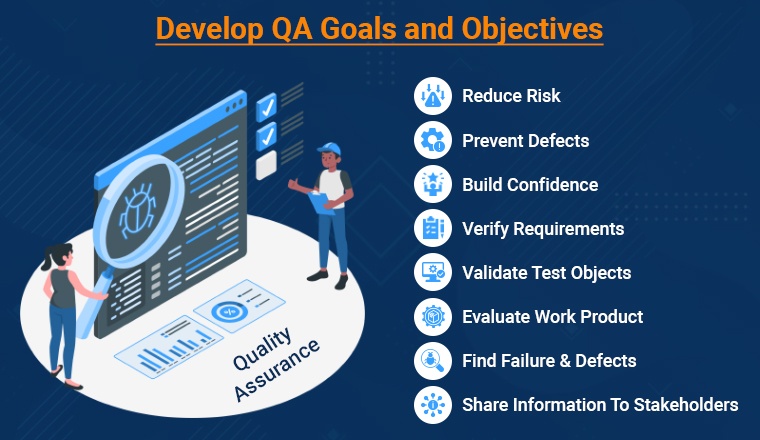
The process of QA is integral. It involves various test cases, test scenarios, and other software testing procedures. When talking about stakeholders, this involves QA and development teams, business analysts, product managers, and other QA team members. Here each member of the QA team is accountable for the testing they performed. You need to build strong accountability within the team so that each one knows the goals that they need to achieve. To establish responsibility, you have to create explicit as well as well-stated objectives and goals.
Here are some of the types of bugs QA teams encounter when they start with a strict quality assurance process.

Each member of the team will perform different types of testing from the unit and integration testing to exploratory testing or functional testing. Where unit testing examines all the individual components of source code and integration testing exposes the defects of components and assesses whether the subsystem works or not. Here are some types of QA goals that can be set for each QA specialist.
- Check open defects- You must take steps against the open defects which have exceeded and quality assurance steps should be taken.
- Code requirement- It needs to ensure that you meet all the code requirements with higher efficiency.
- Prerequisite check-This aims to address all types of software requirements that you define at the initialization of project development. Every detail must be covered.
- Critical Bugs- This type of bug includes high-risk bugs which can interrupt the software functions and hence, these bugs require more attention than others.
2.2 Define Software Testing Process and Plan
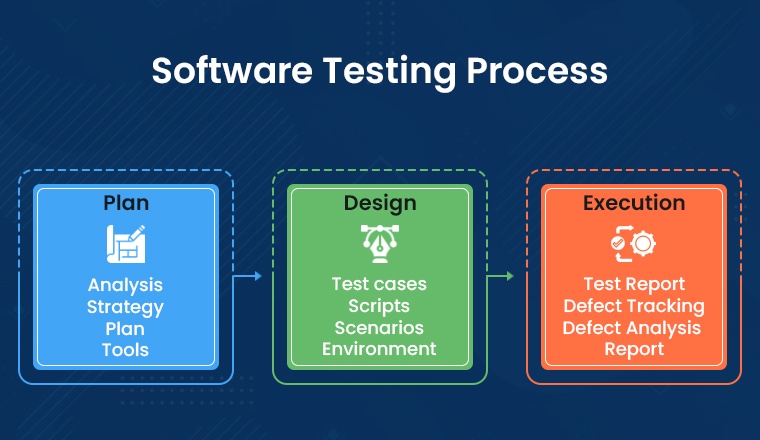
The next step in the process of software testing is the introduction to the test plan. Here you can start with planning your test procedures, develop a roadmap on how to implement sprints, do the sprint planning and define the short-term goals. This will allow the team to be constantly involved at every scale within the project’s phases and improve quality assurance for your business.
You must plan every minute detail of your project if you truly want it to succeed, and software testing is one of those details. This is why one of the most important QA testing best practices is comprehensive preparation.
Prepare a test plan that contains details of testing, by whom, what resources will be required, when the deadline will be met, what the acceptance criteria will be, and what the current status and test results will be. You can also do test automation with the help of your quality assurance tester.
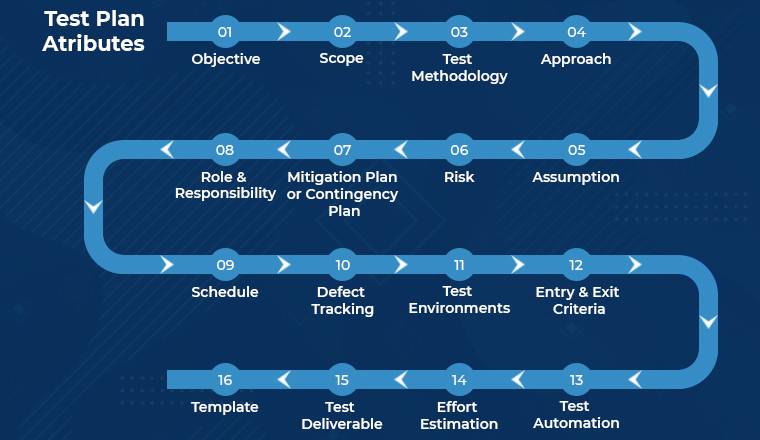
2.3 Imply Multi-Directional Testing Strategy
One of the most apparent but sometimes overlooked Quality Assurance techniques is to employ a variety of QA types. Don’t limit your testing process to just one or two categories. Perform several methods of testing in order to quickly find various sorts of issues.

You need to motivate your development team to build automatic unit tests so that they can evaluate the quality of their code and correct any issues before sending it to QAs to perform testing. Once you have sent the request, the QA team will start with smoke testing. In this QA process, they may either confirm that the code is ready to test or return it to the developers for retesting.
When you apply multi-directional testing in software development, this means the QA teams will test all the test cases thoroughly using multiple testing strategies. In the software quality assurance program, the team members will initially check manually if there are any bugs or not. Then they perform all types of testing like regression testing, non-functional testing, user acceptance testing, and compliance testing to get the right results from this testing process. After making enormous changes and matching release criteria, regression testing ensures that all functionalities are up to date and work seamlessly.
The last phase here is to do user acceptance testing. In this phase test, the product as per user needs to be analyzed to see if it meets all functional requirements or not.
2.4 Ensure It’s A Top-Down Effort
Maintaining a high standard of quality is essential. The QA procedure needs to be communicated as a top priority by the high authority and board. It is not by chance that a company develops and maintains a high-quality QA culture, but it has been the experience of many that when QA is given the top priority at all stages of a business, it is far more probable to be successful and purposeful.
2.5 Implement Code Quality Measurements
Ensure that you quantify, record, review, and monitor your quality goals. The quality of code may be evaluated in several ways. If you want to improve your process, use metrics that are easy to understand and implement.
There are five key elements of software quality, and we will examine how they can be quantified.
- Reliability – How long the system can operate without failure is shown by this metric. Reliability testing is performed to lessen the frequency of unscheduled application restarts.
- To measure reliability, you can count the number of bugs found in the production environment, or by load testing that checks how the software functions when the load is high. Regression testing is also useful to verify the number of defects.
- Performance Efficiency – It describes how quickly a system can respond to a request for action. It can be measured using following metrics:
- Stress Testing: To identify the upper limit of the system capacity.
- Soak Testing: To check how long a system can handle a certain load.
- Performance Monitoring: Detailed metrics as per the user’s perspective.
- Security – Security refers to a system’s capacity to keep sensitive data safe from prying eyes or accidental deletion.
- Scanning the entire application will reveal how many security flaws are there. The vulnerability count can be used as a positive or negative indicator of overall security.
- Maintainability – System adaptability refers to how simple it is to make changes to the program, use it for other purposes, hand it over to a different development team, or adjust it to suit changing business needs.
- A simple way to review the code maintainability is to check the number of lines of the code in each file. Many times, it becomes complex to debug the code if it has more lines. So, less complex code is easy to maintain.
- The Rate of Delivery – The rate at which software is released is also an essential metric to track.
- The key metric to review how often a client is receiving updates is to check the number of software releases.
2.6. Incorporate Agile Methodologies into Software Testing
In software development, the Agile software development approach is followed by the Agile testing practice. Throughout every phase of a sprint, Agile development teams make revisions to the project to make it better. Agile testing is concerned with maintaining a high standard all the way through an Agile development cycle.
Principles of Agile Testing:
| Principles | Advantages |
|---|---|
| Early and continuous testing |
|
| Collective effort |
|
| Close collaboration |
|
| Customer involvement |
|
| Process Improvement |
|
| Adaptable approach |
|
2.7 Combining Automated Testing and Manual Testing
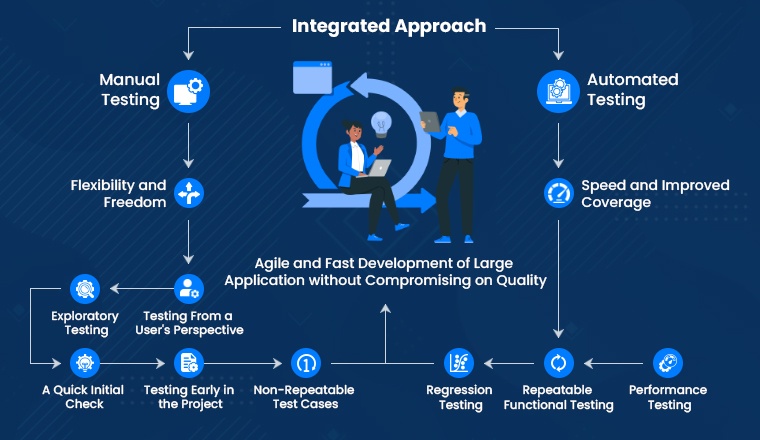
Preferably, your quality assurance (QA) testing process would incorporate both automated and manual testing. The trick is to establish which form of test is best appropriate for each element and phase of the product’s development.
Manual testing enables you to test against a diverse set of situations and scenarios. The QA testers’ comments on the app’s experience and feel will be important. For the testing process, usability testing and ad hoc testing as well as manual tests are ideal. Manual tests should preferably be carried out by extremely competent and professional testers who match a variety of end-user profiles and have knowledge of a variety of devices and operating systems.
Manual testing can be augmented with frequent automated tests to save time during testing. When doing white box testing, load tests, and other types of performance testing, automation is the most suitable method.
Any test that must be run on a regular basis should be automated. Automated testing is convenient, and dependable and will assist you in ensuring that the software functions sufficiently on a technical level.
Automation will not meet all of your testing requirements. Crowdtesting can be used to augment in-house manual testing. This strategy enables rapid testing of your product on a much wider scale.
2.8 Continuous Integration and Continuous Deployment
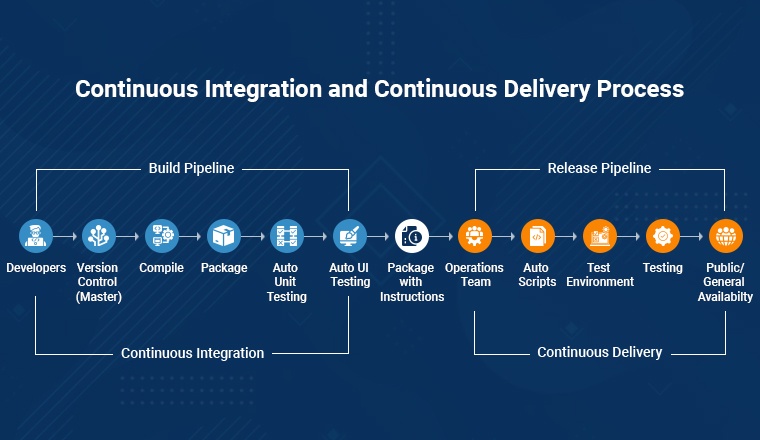
From the standpoint of the QA team, there are several benefits of continuous integration and continuous deployment. One of its major benefits is to quickly obtain a build that includes the most recent additions or fixes.
Continuous Integration is the automatic and instantaneous technique of testing any change made to your codebase. Continuous Deployment is the process of pushing changes to a staging or production system. This simultaneously activates Continuous Integration. This improves the process by adding continuous delivery to make this process faster.
Your development team may have many git branches relating to different features over the development cycle, but only one branch includes the most up-to-date code. When the code is modified, the CI tool verifies this branch and generates a new build, which is then shared with the selected diaries.
2.9 Adopt a Two-Tier Approach to Test Automation
Most of the time, this has occurred to companies when there is a major change in their development process. For instance, the developer who had made exhaustive changes has now moved to a different project. In such cases, the project suffers a delay. The Quality Assurance team is not aware of what testing tools and QA processes were involved. Hence all the tests need to be performed.
So a two-tier approach is introduced, where you apply automation testing tools to augment the testing processes. As a result, the two-tiered approach is in two directions. Tier one implies every contribution to the codebase. It also enables quick validation of developer changes. This needs to be performed with all sanity testing and ad-hoc testing that takes some extra minutes to complete. But ensures good results. The test process in tier two goes through regression testing. You can schedule it to run at night with added test coverage. It is a challenging task to choose which tier should perform which type of software QA testing.
2.10 Implement Exploratory and Ad-hoc Testing
Exploratory testing involves simultaneous learning, test design, and execution. Testing requires testers to have expertise, insight, and creativity in order to find bugs. Tests for exploratory purposes are conceived and carried out on the spot. The outcomes are then analyzed and applied to future test planning and, maybe, issue fixes.
Ad-hoc testing is about performing random testing without any plan. It does not follow any documentation to perform the activity.
The methods are highly effective for testing application usability since it mimics actual user actions. Rapid evaluation of the system is possible with this method, allowing for timely response and the identification of test areas.
2.11 Conduct Risk-based Testing
Here you’re listing your risks and prioritizing your test execution based on the risks. We can say that it is one of the most important aspects of agile methodology which cannot be neglected.
If you’re still confused, here is a simple answer by a techie in their quora to revolutionize risk based testing, have a look:
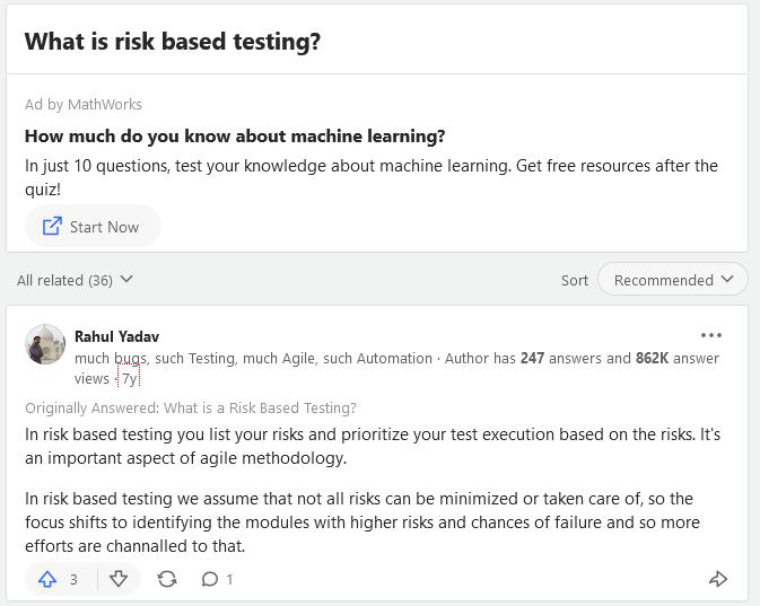
Risk-based testing is a methodology for detecting the most dangerous hazards throughout the testing process. This technique entails identifying project risks, prioritizing them, and arranging the testing process accordingly. This enables QA engineers to focus on the most significant risks that might jeopardize the product’s overall performance.
It is beneficial for both the QA department and customers. The QA department incorporates a risk-based testing strategy early in the software development process; they may ease the code architecture and make the product simpler to test.
When testing engineers take a risk-based approach, they focus on the most likely issues during product use. As a result, it contributes to the reduction of the spectrum of testing operations.
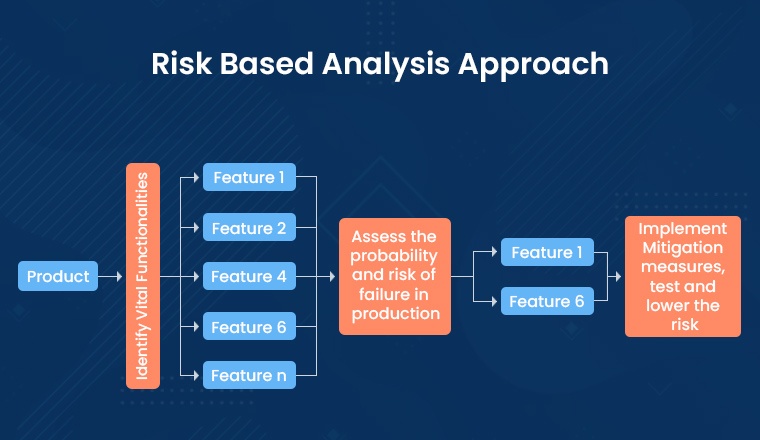
When a QA team uses a risk-based testing strategy, they focus on the functionality that is most prone to errors. This enhances the customer experience. Thus, you may obtain a high-quality product if you lack the resources necessary to test the product’s performance thoroughly.
2.12 Frequent Regression Testing in the Development Process

In the software development lifecycle, numerous types of testing take place. The QA specialists must understand what bugs to report, what information to include in reports, and how to structure reports. It also shows if you need to change the QA testing methods. Conventional methods like black-box testing or white-box testing have now changed. There are other additional methods which include load testing, stress testing, and other QA best practices for software testing. In addition, the customer and the QA team must agree on the circumstances of the testing environment and the much-needed frequency of regression testing and retesting.
Not only that, regression testing opens the gates of advantages for both the QA team and the customers.
For the QA department, Regression testing includes documenting the process of performing autotests in detail. This documentation provides system specs, test designs, bug reports, operator findings, and other information about software. Not just testing engineers but also developers and stakeholders may make use of this information.
Another significant benefit of regular regression testing is that it enables testing engineers to ensure that new product features do not impact the stability of the core program, which is critical for maintaining a high degree of product quality.
For the customers, Updates have the potential to introduce flaws in a software product. Regression testing assists quality assurance engineers in reducing the number of problems in a product.
Automated tests enable quality assurance experts to accelerate quality assurance reviews and ease the software upgrade process.
Further Read – What is Regression Testing: Types and Techniques
2.13 Utilize Test Management Tools Effectively
Software testing solutions known as test management tools facilitate the testing process for quality assurance and software testing teams. Such tools may be used with your existing software, including your test automation frameworks, continuous integration and delivery tools, and bug-tracking software.
You’ll need to choose between an open-source platform (which costs less but has fewer features and less support) and a commercial platform (which is faster, easier to use, has more features, and more cost). Smaller businesses often find luck with open-source software.
Let’s go through the important software testing tools and their key functionalities.
| Software Testing Tool | Key Functionalities |
|---|---|
| Selenium |
|
| Appium |
|
| Katalon |
|
| TestRail |
|
Other than these tools, Zephyr, SpiraTest, TestPad, Xray, Tuskr, and many more are also used for Software testing. So, before selecting any tool, read all its features, advantages, and limitations; and select the best-fit one that you can utilize effectively.
2.14 Test Across Multiple Browsers and Devices
Testing your new product/service/website on a wide variety of browsers and devices is essential. Avoid having your site load normally for Android users while leaving iPhone users with an indefinite loading screen. More favorable comments and participation from your audience will result from testing your content on all the most popular browsers and devices.
BrowserStack is a good tool to test applications across multiple devices. Let’s see some of its features and benefits:
- BrowserStack is a cloud based tool.
- It can be used to test the code across 3000+ real devices and browsers.
- It supports automated as well as manual testing.
- One can also test the application in multiple resolutions as well.
- Compatibility of the browser can also be tested using browserstack.
2.15 Hold On to Peer Reviews Quite Often
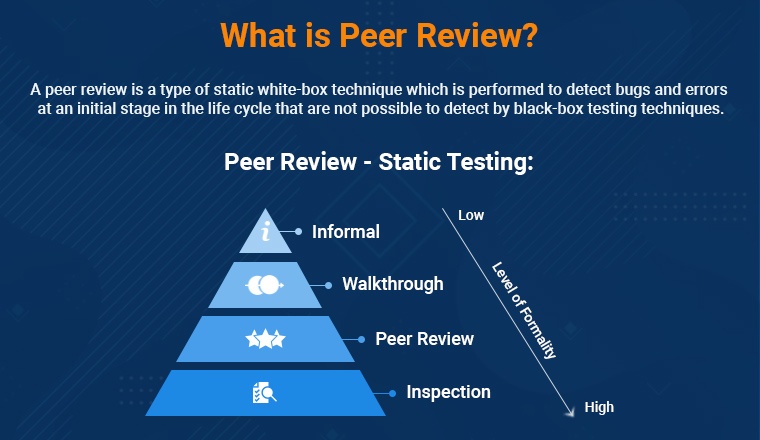
It is said to be a good practice in software development to take peer reviews periodically. The main reason for taking peer review is to know what the competitors think of your product and what is their take on it. This method enables continuous verification, that all changes have been made and the installation has fulfilled your high requirements. It also benefits your team by exposing each of your team members to different projects and groups on a regular basis, providing continuous learning and growth opportunities.
Now that you have surpassed the first layer – the physical layer, you can now skip testing and correcting codes. You don’t have to make it complex, just simply utilize the development tools and start executing the plan as per the scope of the work, a collaboration between teams, documentation, changes and modifications, and deployment procedures.
2.16 Adhere to Industry Compliance
You as a business must know and understand the standard measures of compliance. Every sector or industry has its own set of rules and laws that firms must follow to protect their company’s data as well as consumers’ data. Speaking of compliance acts, you can never forget the General Data Protection Regulation (GDPR) act that aims to protect EU residents to protect the personal data of their country and customers. For the healthcare sector, the Health Insurance Portability and Accountability Act (HIPAA) safeguards patients’ health information in the United States. The banking sector, specifically the Payment Card sector has the Payment Card Industry Data Security Standard (PCI DSS) act that safeguards customers’ payment card information globally. To guarantee that a product fulfills all criteria, quality assurance teams must do compliance testing.
2.17 Conduct External Quality Review
It is always a good way of making your app better and more efficient. Take a second view of your product or set some fresh eyes to review it, which can turn out to be beneficial in software development. You can choose to invite an independent specialist to analyze your software code and perform a technical assessment as a project manager, product owner, team lead, or a business owner.
They should know a basic summary as well as ideas for the team to consider to improve their performance. While such a step is primarily intended for software developers, it will also aid QAs greatly. After all, both developers and testers are working towards achieving high-quality code.
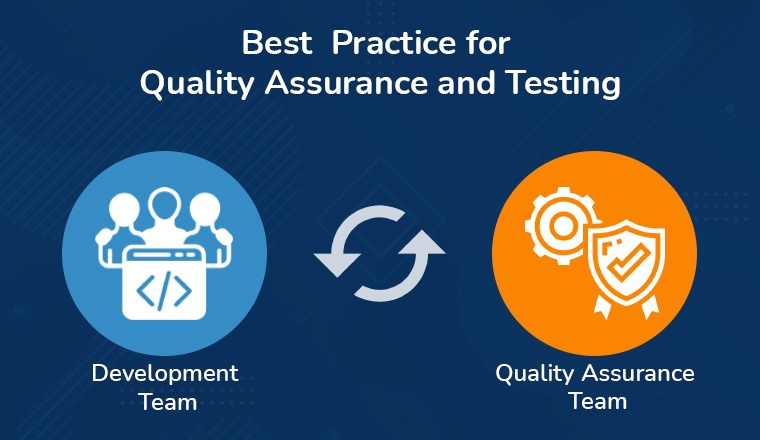
2.18 Continuously Improve the QA Process
The Continuous Improvement Process (CIP) refers to the never-ending quest for betterment in any area of operation. Based on the Shewhart Cycle (Plan, Do, Study, Act), this four-step method systematically plans, sequences, and implements improvement actions utilizing data.
| Plan |
|
| Do |
|
| Study |
|
| Act |
|
Teams may utilize the data gathered from quality assurance as a springboard for ongoing progress. Also they can identify defects and ineffective processes. The fix isn’t just meant to stop faulty functions from deployment, but it is also crucial to remove the factors that lead to these errors. The concept of constant improvement comes into play here. The group conducts in-depth research into the issue at hand and comes up with ideas on how to improve efficiency.
2.19 Utilize Crowdtesting Approach
One other aspect of the quality assurance jigsaw is crowdtesting. Crowdtesting is a process where a company or organization uses a group of engineers to test their software to increase release velocity.
Crowdtesting has various benefits like:
- One can create a team with diverse software testers to bring a diverse set of perspectives to the process like different levels of expertise, unique experiences, etc. This can increase the effectiveness of the testing process.
- Crowdtesting can be beneficial in reducing the overall process time. It can lead to quicker results and productivity.
- Crowdtesting is a cost effective approach as the particular group can solve the queries faster and help in improving the STLC process.
2.20 Manage and Maintain Documentation
Every step of the software testing process should be meticulously recorded. It can include test plans, test cases, defect reports, or any other thing that is written by the QA team.
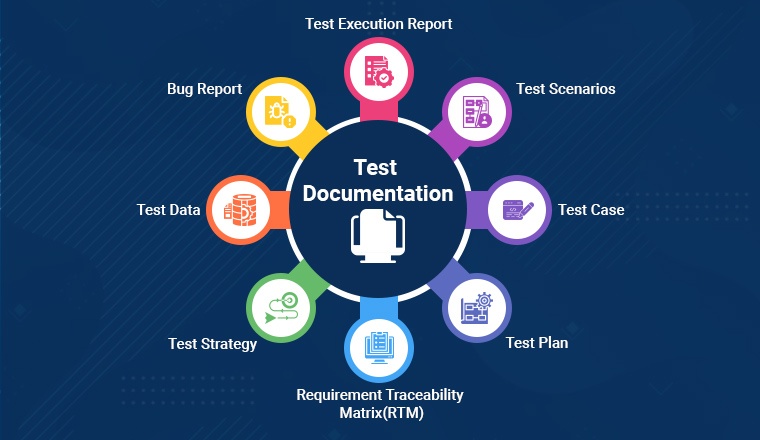
Each of these documents has a specific structure and set of requirements that must be met in order for them to be effectively built and managed. To ensure that the developers do not miss any bugs, all bugs should be recorded and reported. Documentation is also useful in later phases of the project: if a bug that was previously detected and addressed reappears, this knowledge will enable developers to fix it faster this time. Additionally, documentation aids testers by demonstrating that they carry out their responsibilities diligently.
However, high-quality documentation is more important than just documentation. If testers report issues in an ambiguous manner, developers and project managers will spend more time attempting to understand the problem rather than fixing it. However, if the documentation procedure is clear and rigorous, it becomes easier and more efficient for everyone to understand the process.
3. Conclusion
This extensive blog helped in understanding all the QA best practices for software testing involved in making high-quality software. You may find multiple quality management tricks in abundance but which one to trust is a matter of intelligence. All you need to do is to draft a test strategy, manage the quality standard and check the product from the user’s perspective. Do it by performing continuous testing and quality control measures. The software team should ensure it meets all the requirements and that the developed software product is of higher quality. Let’s follow these best practices for software testing and save more time in repetitive development procedures.


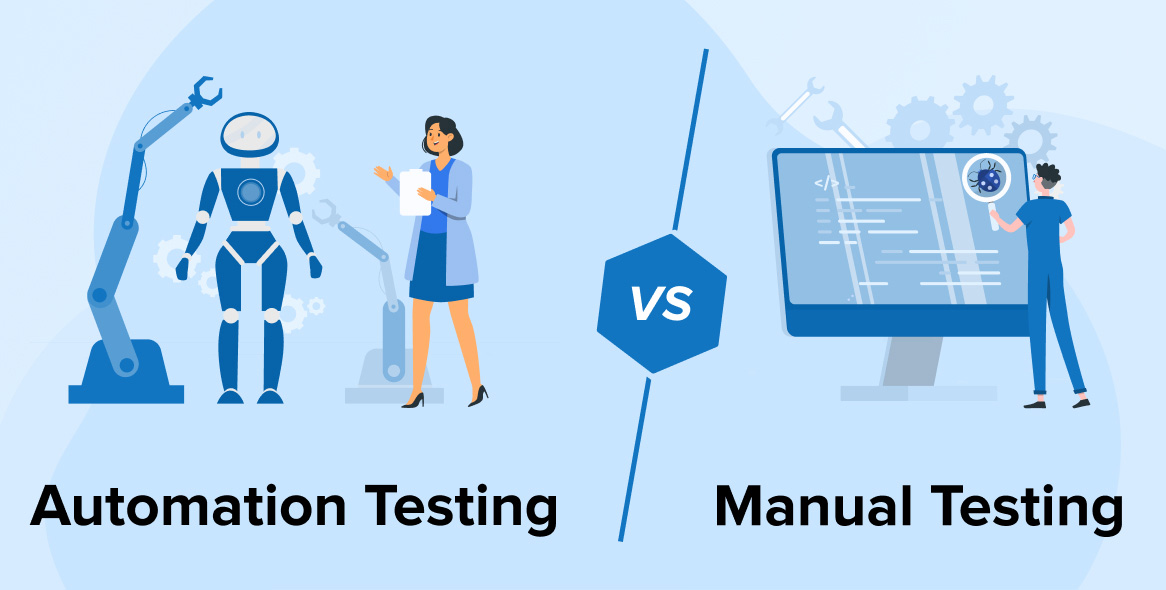
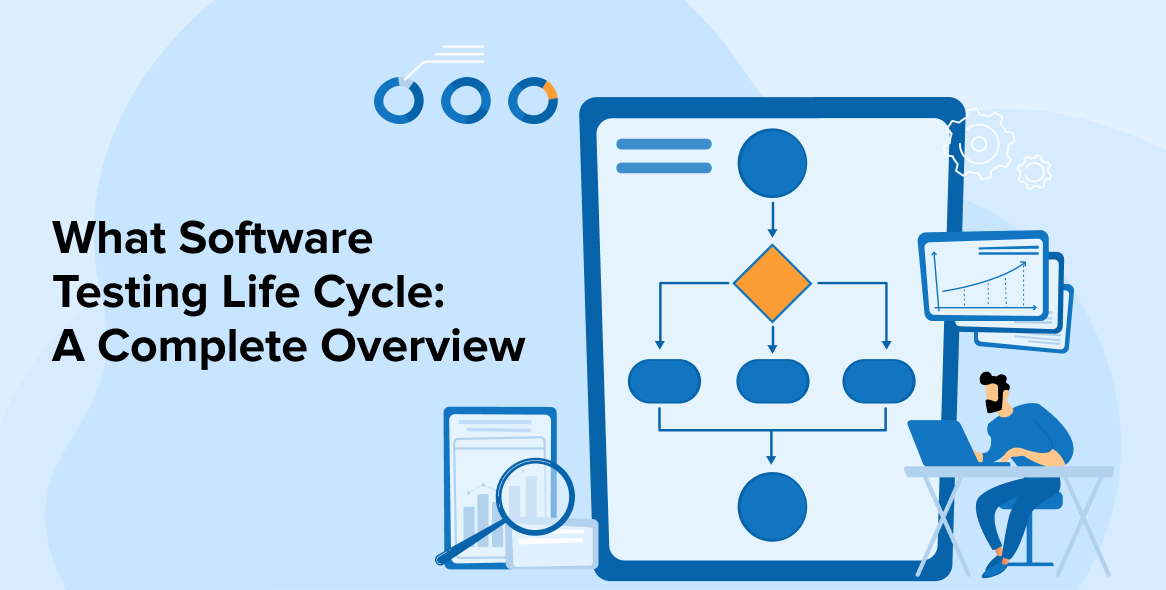


Generally the failure of the applications or software occurs due to its improper quality testing. In this blog, the writer has shown a systematic approach of quality testing which leads to better result and a good quality of application or software.These approach or practices is very well illustrated in the article.
In every product, quality is most important. So, how can we ignore Quality assurance for software development products? There are several QA best practices that ensure the software quality and that includes test plans, test cases, test scenarios, regression testing processes, and many more.
As a newcomer to the testing industry, I have quickly come to understand the value of QA best practices. These practices help ensure that the software product meets its functionality and quality, while also reducing the errors and defects. A more successful and efficient development process may be achieved by using QA best practices such as early testing, constant feedback, and communication within the development team.
As a tester, I found this article to be very informative and useful for testing a software product. The author does an excellent job of explaining the best QA best practices, and I especially appreciated the section on risk-based testing. I will definitely use this article as a reference for my upcoming project.